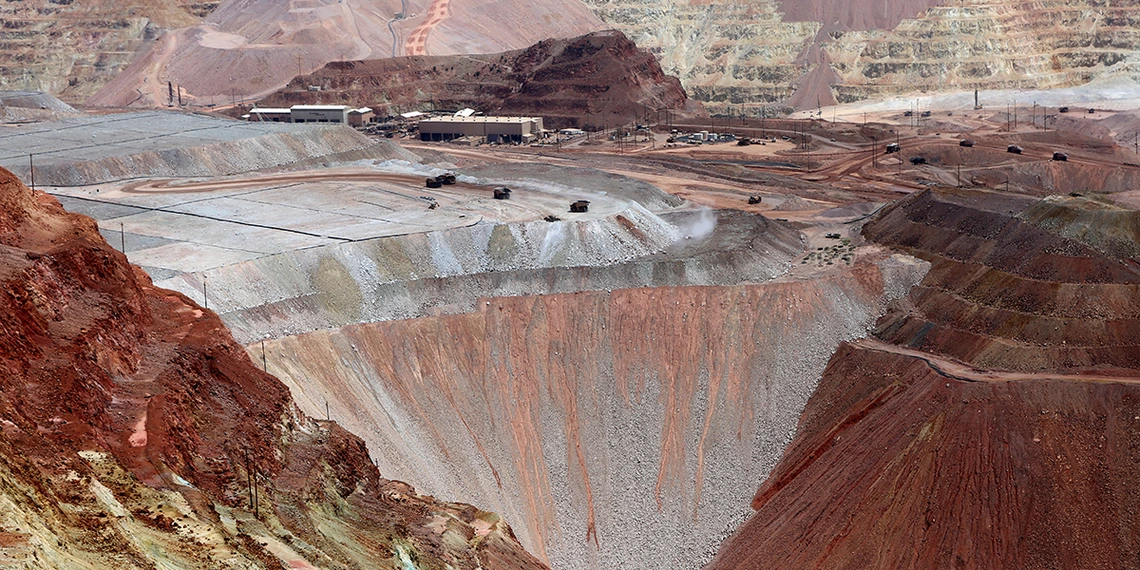Ushering in a New Era of Mine Waste Reclamation

Mining has long been a key part of Arizona’s economy, from the boomtowns that sprouted up in the 1800s to today’s streamlined industries that operate across the state, but it has often come at a cost to the environment and public health.
When a site is established, excavation begins on thousands of tons of earth, desired metals are collected, and remaining nontoxic rock is divided into tailing stands and waste rock, which is then capped with 6 inches to 1 foot of soil. It’s those leftovers that the University of Arizona’s Center for Environmentally Sustainable Mining (CESM) is looking to improve.
An Airborne Hazard
Tailing stands are collections of coarse rock, while waste rock is comparable to gravel in texture. Waste rock is neither fertile nor toxic, but it is a dust hazard. Uniquely Arizona phenomenon such as monsoon downpours — with their booming thunder, tremendous lightning and torrential rains — and haboobs, which bring clouds of dust to a stretch of barren land between Phoenix and Tucson, dislodge the dust in waste rock, swirling it to nearby communities.

Copper tailings on their own are not harmful to humans, but they can inflame respiratory problems if swept up into summer monsoons and haboobs.
Short-term exposure to dust exacerbates health conditions in people with heart or lung disease, emphysema and asthma. It can also accelerate lung cancer and cause respiratory disease in children.
Julie Neilson, director of the CESM and associate research professor in the University of Arizona’s Department of Soil, Water and Environmental Science, and her team work with mining companies to determine solutions through phytostabilization. The process uses plants to immobilize the soil system, as well as the dust beneath, so that it can’t be blown or washed away. In other words: Keep the dust stable. “The soil immediately controls dust, which is like flour and can be kicked up by any wind event. The soil, too, can blow or wash away,” Neilson says. “Plants help stabilize the soil cap.”
Other benefits to this containment strategy: reintroducing carbon sequestration (using plants to remove carbon from the air) and regenerating the ecosystem. “If you’re taking out thousands of acres of desert to perform mining operations and store waste materials, that’s a lot of plants you’ve removed,” Neilson says. “We don’t want to leave these degraded tracts of land. In the desert, things don’t grow back on desolate lands — we need to help the system along so plants can grow back.”
Giving Old Soil New Life
That’s where problems crop up. The plants don’t grow very well on tailing stands or waste rock because the soil is nutrient-poor. Neilson and researchers from the CESM are at mines throughout southern Arizona documenting exactly how nutrient-poor these two types of waste are via bioindicators and tests of soil quality. Additionally, they’re studying which plants could build up nutrients on these soils so that when other seeds blow in, they can germinate. Could they amend the soil with compost?
CESM scientists are relying on native plants, the first being pioneer plants — hearty, rugged plants that can stand harsh conditions. “Quail bush is a really good pioneer plant,” Neilson says. “It’s an amazingly resilient plant that grows in salty soil with very little water. Grasses are also good pioneers — they germinate quickly and build up organic matter in the surface.”

Because tailing stands and waste rocks are nutrient-poor, CESM scientists want to introduce pioneer plants that thrive in difficult conditions first before attempting to complete the phytostabilization process.
The eventual goal, once pioneer plants are established and have reintroduced nutrients into cap soil, is to plant grasses, shrubs and trees — such as creosote, cholla and prickly pear cactus, as well as mesquite and palo verde trees — as long as they aren’t in a position to topple over during wind or rain, and destabilize the soil again.
The United States is one of the largest global consumers of mineral resources, and Arizona is ranked first among states in the value of nonfuel mineral resources produced each year*. And while centuries of process perfection have led to greener mining practices, Neilson was careful to emphasize that these are advancements at active mines. Legacy mines, mines that are no longer in use, “are a whole other issue,” Neilson says. Unremediated, historic mining sites remain a threat because of toxic dust with high levels of arsenic and lead.
The work being done today is a collaboration between the CESM and international mining companies with operations in the American Southwest and northern Mexico. The companies pay to be members of this consortium and allow the UA to conduct research at active mining sites. “The advantage of this approach is that we try to find solutions using resources that are reasonably available to the mine: their sites, their machines, etc.
“[Mining companies] have a genuine interest, whether for PR or health reasons, in revegetating,” Neilson says. “They just don’t have the tools or technology to get this research done. I have been amazed at the willingness and the eagerness of mining companies to advance these technologies and develop these resources.”
*source: Center for Environmentally Sustainable Mining
